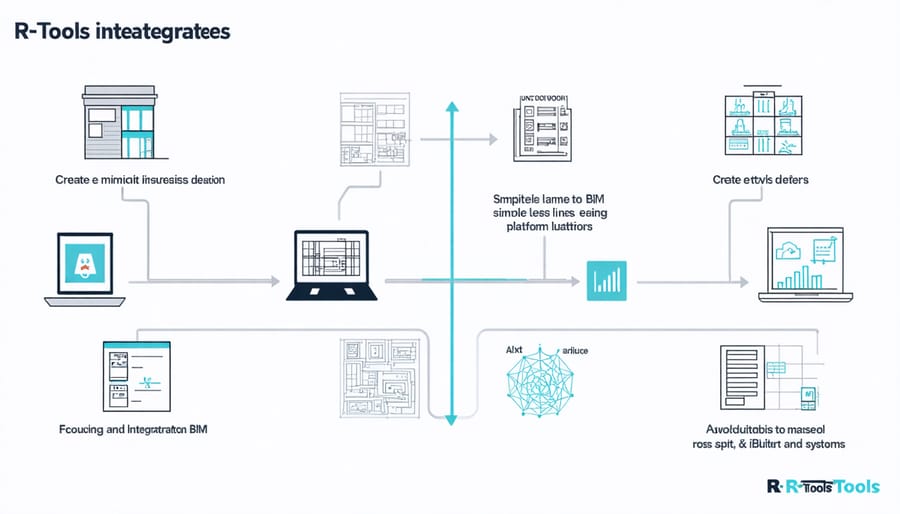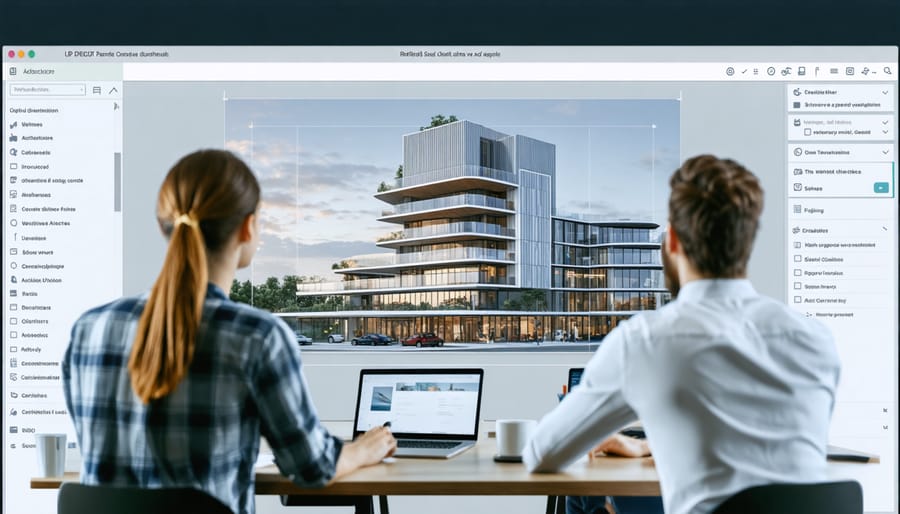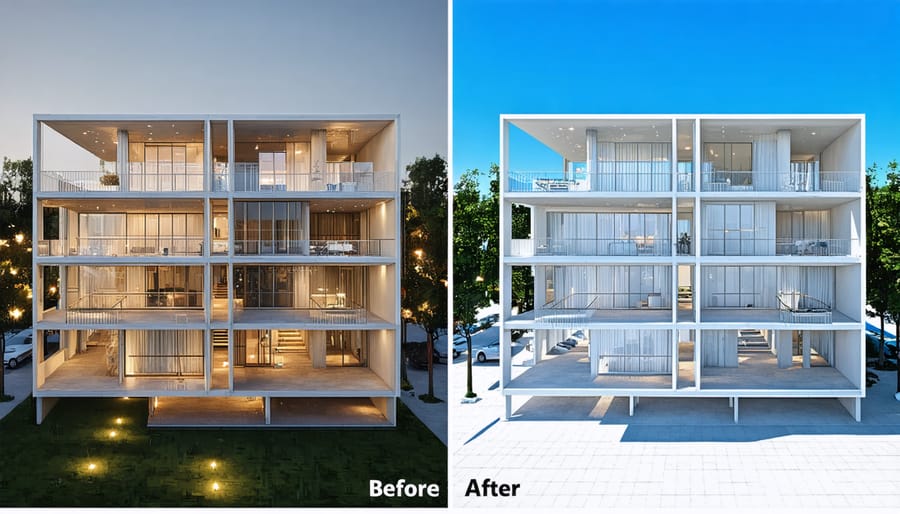R-Tools Technology revolutionizes modern architectural workflows by seamlessly integrating design, collaboration, and project management capabilities into a unified digital ecosystem. As a cornerstone of today’s collaborative architectural design tools, this platform empowers firms to streamline complex design processes while maintaining precise control over project deliverables.
Industry leaders leverage R-Tools’ advanced parametric modeling features and real-time visualization capabilities to reduce design iterations by up to 40%, while simultaneously enhancing stakeholder communication and decision-making efficiency. The technology’s robust data management infrastructure enables seamless integration with existing BIM workflows, ensuring consistency across multiple project phases and team members.
For architecture firms navigating the digital transformation landscape, R-Tools Technology represents a strategic investment in operational excellence, offering quantifiable improvements in project delivery timelines and design quality. Its AI-powered optimization algorithms and cloud-based collaboration features position it as an essential tool for firms seeking to maintain competitive advantage in an increasingly technology-driven industry.
Understanding R-Tools Technology in Architecture
Core Components of R-Tools
R-Tools technology encompasses several essential components that work together to create a robust architectural design and collaboration platform. The Building Information Modeling (BIM) integration module serves as the foundation, enabling seamless coordination between different design elements and structural systems. This core feature allows for real-time model updates and clash detection across multiple disciplines.
The advanced visualization engine renders complex 3D models with exceptional detail, supporting both conceptual design development and detailed construction documentation. Project teams can leverage the parametric modeling capabilities to create and modify building components while maintaining design intent and relationships between elements.
The collaboration hub facilitates synchronized workflows among team members, featuring version control, change tracking, and automated notification systems. This ensures all stakeholders remain informed about project developments and can contribute effectively to the design process.
Data management tools within R-Tools handle large volumes of project information, from material specifications to cost estimates, while maintaining data integrity and accessibility. The integrated analysis module performs structural calculations, energy simulations, and building performance assessments, providing valuable insights for informed decision-making throughout the project lifecycle.
Integration with BIM Systems
R-tools technology seamlessly integrates with leading Building Information Modeling (BIM) platforms, enabling smooth data exchange and workflow optimization across various design and construction phases. The technology supports native file formats from major BIM software, including Autodesk Revit, ArchiCAD, and Bentley Systems, ensuring compatibility with existing infrastructure.
Through its advanced API framework, r-tools facilitates real-time collaboration between team members working on different aspects of the project. The integration allows for automated clash detection, quantity takeoffs, and cost estimation directly within the BIM environment. Project managers can track changes, manage revisions, and coordinate workflows without switching between multiple applications.
The system’s plug-in architecture enables customization based on specific project requirements, while maintaining data integrity throughout the building lifecycle. Design teams can leverage r-tools’ computational capabilities for parametric modeling and performance analysis while working within their preferred BIM platform. This integration strategy reduces data loss, minimizes errors from manual transfers, and streamlines the overall project delivery process.

Real-Time Collaboration Features
Simultaneous Design Capabilities
R-tools technology revolutionizes architectural collaboration by enabling multiple designers to work on the same project simultaneously in real-time. This advanced platform utilizes cloud-based synchronization and intelligent conflict resolution to ensure seamless coordination between team members, regardless of their physical location.
The system implements a sophisticated version control mechanism that tracks all changes and maintains a comprehensive history of modifications. Each architect can work on different aspects of the project while the platform automatically manages file dependencies and updates. This eliminates the traditional bottlenecks associated with sequential design processes and significantly reduces project timelines.
To facilitate effective collaboration, the platform features role-based access control, allowing project managers to assign specific permissions and responsibilities to team members. Architects can work on their designated sections while maintaining visibility of others’ progress, ensuring cohesive design development.
The technology includes built-in communication tools that enable instant feedback and decision-making. When conflicts arise, the system alerts affected team members and provides tools for resolution. Real-time visualization features allow architects to see how their individual contributions integrate with the overall design, maintaining project coherence throughout the development process.
Case studies have shown that firms implementing r-tools technology have experienced up to 40% reduction in design cycle times and significantly improved coordination between team members, particularly in complex projects involving multiple stakeholders.

Version Control and Change Management
Version control in r-tools technology provides a robust framework for managing design iterations and tracking modifications throughout the project lifecycle. The system implements a comprehensive change management protocol that enables teams to maintain detailed records of design evolution while ensuring coordination among stakeholders.
At its core, the version control system maintains a centralized repository where all design changes are logged, timestamped, and attributed to specific team members. This creates an auditable trail of modifications that proves invaluable for quality control and compliance purposes. Project managers can easily review the progression of design elements, compare different versions, and roll back to previous iterations when necessary.
The change management interface features intuitive diff tools that highlight modifications between versions, making it simple to identify and evaluate design updates. Team members can attach comments and documentation to each change, providing context and rationale for design decisions. This collaborative approach ensures that all stakeholders remain informed about project developments and can contribute effectively to the design process.
For complex projects, r-tools implements branching and merging capabilities that allow teams to work on multiple design variants simultaneously. This feature enables architects and engineers to explore different solutions without disrupting the main design thread. The system automatically detects conflicts between branches and assists in reconciling divergent changes, maintaining design integrity throughout the process.
Security features include role-based access control and approval workflows, ensuring that modifications undergo proper review before implementation. This systematic approach to version control significantly reduces errors and enhances project coordination.
Case Study: R-Tools in Action
The implementation of R-Tools technology in the Hudson Square Development Project demonstrates its transformative impact on large-scale architectural endeavors. This $350 million mixed-use development in downtown Manhattan serves as a prime example of how R-Tools can streamline complex design processes while transforming urban spaces.
The project team, led by Foster + Partners, faced the challenge of coordinating multiple stakeholders across different time zones while maintaining design integrity throughout the 18-month development phase. By implementing R-Tools’ collaborative platform, the team achieved remarkable results:
• 40% reduction in design iteration time
• 65% decrease in coordination-related errors
• 30% improvement in stakeholder communication efficiency
• 25% reduction in overall project timeline
The platform’s real-time visualization capabilities enabled architects to make critical decisions during virtual design reviews, eliminating the need for frequent in-person meetings. Project manager Sarah Chen notes, “R-Tools allowed our team to identify and resolve potential conflicts before they became costly issues on-site. The ability to manipulate 3D models in real-time while conducting remote design sessions was game-changing.”
A particularly noteworthy achievement was the integration of complex mechanical systems within the building’s distinctive curved facade. Using R-Tools’ clash detection features, engineers identified and resolved 127 potential conflicts during the pre-construction phase, saving an estimated $2.8 million in potential rework costs.
The technology’s data analytics capabilities also proved invaluable for performance optimization. The team utilized R-Tools’ environmental analysis modules to optimize the building’s energy efficiency, resulting in a projected 35% reduction in operational energy costs compared to similar structures.
This case study demonstrates how R-Tools technology can significantly enhance project outcomes when properly implemented in large-scale architectural projects. The combination of collaborative features, real-time visualization, and advanced analytics provided the framework for successful project delivery while maintaining design excellence.

Implementation Strategies
Training and Team Adoption
Implementing r-tools technology across architectural teams requires a structured approach focused on comprehensive training and systematic adoption strategies. Success begins with identifying champions within each team who can drive adoption and provide peer support. These technology advocates should undergo advanced training first, enabling them to assist colleagues during the transition period.
A phased implementation approach typically yields the best results. Start with small, manageable projects to allow teams to build confidence while maintaining productivity. This approach aligns with established smart building team collaboration practices and helps minimize disruption to ongoing projects.
Training should incorporate both technical skills and workflow integration. Key areas to cover include:
– Basic software functionality and navigation
– Project setup and file management
– Collaboration protocols and best practices
– Quality control procedures
– Documentation standards
Regular feedback sessions are essential during the implementation phase. These meetings help identify challenges early and allow for timely adjustments to the training program. Consider establishing a dedicated support channel where team members can quickly access help when needed.
To ensure long-term success, develop standardized procedures and documentation that reflect your organization’s specific workflows. This documentation should be regularly updated to incorporate new features and lessons learned from practical application.
Security and Data Management
In today’s interconnected design environment, security and data management are paramount concerns for architectural firms implementing r-tools technology. The platform incorporates multiple layers of security protocols, including SSL encryption, two-factor authentication, and role-based access controls to protect sensitive project information.
Project administrators can establish granular permission levels, ensuring team members access only the data relevant to their responsibilities. This hierarchical approach maintains data integrity while facilitating efficient collaboration. Version control systems track all changes, creating detailed audit trails and allowing teams to revert to previous iterations when necessary.
Data backup occurs automatically at regular intervals, with redundant storage across multiple secure servers. This distributed approach minimizes the risk of data loss and ensures business continuity. The system also employs advanced conflict resolution protocols to prevent data corruption during simultaneous user access.
For firms working with international clients or across multiple jurisdictions, r-tools technology complies with major data protection regulations, including GDPR and CCPA. Regular security audits and penetration testing verify the platform’s resilience against emerging cyber threats.
The platform’s data management capabilities extend to BIM integration, allowing secure sharing of large model files while maintaining version control. Analytics tools provide insights into data usage patterns, helping firms optimize storage and improve workflow efficiency while maintaining strict security standards.
Future Developments
R-tools technology is poised for significant advancements in the coming years, with several groundbreaking features currently in development. Industry experts anticipate the integration of advanced artificial intelligence capabilities that will enhance predictive modeling and automate routine design tasks. These developments align with broader sustainable construction innovations while maximizing efficiency in architectural workflows.
Machine learning algorithms are being developed to analyze historical project data and suggest optimal design solutions based on successful past implementations. This predictive capability will enable architects and engineers to make more informed decisions during the early stages of project development. Additionally, enhanced visualization features utilizing augmented reality (AR) and virtual reality (VR) technologies are expected to revolutionize how design teams collaborate and present concepts to clients.
Another significant development is the integration of building performance simulation tools that will enable real-time analysis of energy efficiency, structural integrity, and environmental impact. These capabilities will streamline the decision-making process and ensure compliance with evolving building codes and sustainability requirements.
Cloud-based collaboration features are being expanded to include advanced version control systems and automated conflict resolution tools. These improvements will facilitate seamless coordination among multiple stakeholders while maintaining project integrity across different time zones and locations. The integration of blockchain technology for secure project documentation and smart contracts is also under consideration, potentially transforming how architectural projects are managed and executed.
These upcoming features are expected to significantly impact architectural innovation by reducing design time, improving accuracy, and enabling more sophisticated analysis of complex building systems.
R-tools technology represents a significant leap forward in architectural and construction project management, offering unprecedented efficiency, accuracy, and collaboration capabilities. By implementing these advanced tools, organizations can reduce project timelines, minimize errors, and enhance communication across all stakeholders. The proven track record of successful implementations across numerous high-profile projects demonstrates the technology’s reliability and return on investment. As the construction industry continues to evolve, early adopters of r-tools technology position themselves at the forefront of innovation, gaining a competitive edge in an increasingly digital marketplace. For firms looking to enhance their project delivery capabilities and streamline their workflows, r-tools technology presents a clear path forward. The time to embrace this transformative technology is now, as it becomes an increasingly essential component of modern construction and architectural practice.

